Russian Imperial Army and the strategic plan of Russia on the eve of the First World War
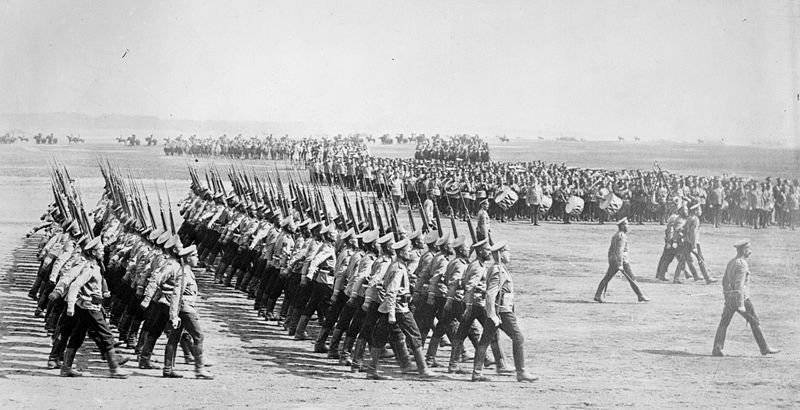
In Soviet times, it was believed that the Russian Imperial Army entered the First World War completely unprepared, was “backward” and this resulted in great losses, a shortage of weapons and ammunition. But this is not a completely correct judgment, although the tsarist army lacked shortcomings, as in other armies.
The Russo-Japanese War was not lost for military reasons, but for political reasons. After it, tremendous work was carried out to restore fleetreorganization of forces, elimination of deficiencies. As a result, the Russian army was second only to the German in preparation for the First World War. But we must take into account the fact that the German Empire purposefully prepared for a military solution to the question of redistributing spheres of influence, colonies, and domination in Europe and the world. The Russian imperial army was the largest in the world. After mobilization, Russia exposed 5,3 million people.
At the beginning of the 20th century, the territory of the Russian Empire was divided into 12 military districts plus the area of the Don Army. At the head of each was the commander of the troops. Liable for military service were men aged from 21 to 43 years. In 1906, the service life was reduced to 3 years, which made it possible to have an 1,5-million army in peacetime, besides, two-thirds consisted of soldiers of the second and third year of service and a significant number of reservists. After three years of active service in the ground forces, a man of 7 years was in the reserve of the 1 class, 8 years of age - the 2 class. Those who did not serve, but were fit for military service, because not all conscripts were taken to the army (there was a surplus of them, a little over half of the conscripts were taken), they were recorded in the militia. Recorded in the militia were divided into two categories. The first category - in case of war, they had to replenish the army in force. The second category — those who were removed from the military service for health reasons were recruited there; from it, they planned to form battalions (“squads”) of the militia from the war. In addition, the army could get and at will, a volunteer.
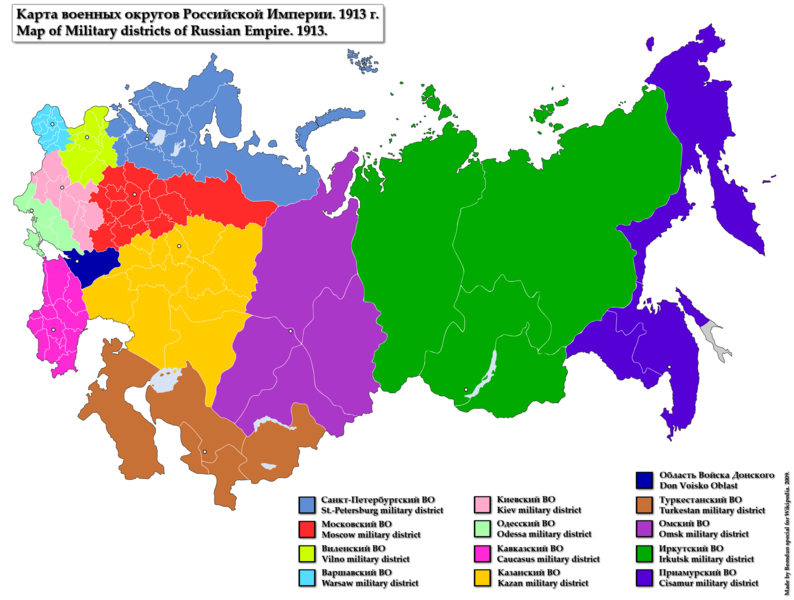
It should be noted that many peoples of the empire were exempted from military service: the Muslims of the Caucasus and Central Asia (they paid a special tax), the Finns, small peoples of the North. True, there were few "foreign troops." These were irregular equestrian formations, to which representatives of the Islamic peoples of the Caucasus could enroll on a voluntary basis.
The service was carried by the Cossacks. They were a special military estate, there were 10 of the main Cossack troops: Don, Kuban, Terek, Orenburg, Ural, Siberian, Semirechensk, Trans-Baikal, Amur, Ussuri and Irkutsk and Krasnoyarsk Cossacks. Cossack troops exhibited "servants" and "militias". The “servants” were divided into 3 categories: preparatory (20 - 21 year); front (21 - 33 of the year), front Cossacks carried direct service; spare (33 - 38 years), they were deployed in the event of war to make up for losses. The main combat units of the Cossacks were regiments, hundreds and divisions (artillery). During the First World War, the Cossacks put up 160 regiments and 176 individual hundreds, along with the Cossack infantry and artillery more than 200 thousand people.
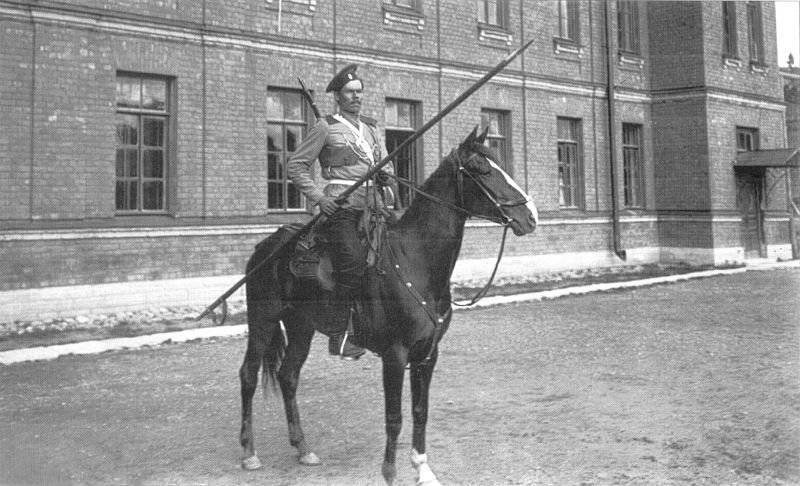
Cossack Life Guard Cossack regiment.
The main organizational unit of the Russian army was the corps, it consisted of 3 infantry divisions and 1 cavalry division. During the war, each infantry division was reinforced by a cavalry Cossack regiment. In the cavalry division there were 4 ths. Sabers and 4 regiment (dragoon, hussar, Ulan, Cossack) on 6 squadrons, as well as a machine-gun team and artillery division from 12 guns.
The infantry was armed with a 1891-mm magazine rifle (Mosin rifle, three-line) since 7,62. This rifle has been produced since 1892 in Tula, Izhevsk and Sestroretsk armory factories, due to a lack of production capacity, were ordered abroad - in France, the USA. In 1910, a modified rifle was adopted. After the adoption in 1908 of the "light" ("offensive") sharp-nosed bullet, the modernization of the rifle followed, so a new curved aiming bar of the Konovalov system was introduced, which compensated for the change in the trajectory of the bullet. By the time the empire entered the First World War, Mosin rifles were produced in the dragoon, infantry and Cossack varieties. In addition, in May 1895, by decree of the emperor, the Nagant revolver chambered for the 7,62 mm cartridge was adopted by the Russian army. By July 20, 1914, in the Russian troops, according to the report card, there were 424 434 units of the Nagant revolver of all modifications (according to the state, 436 210 were supposed), that is, the army was almost completely provided with revolvers.
Also, the army was armed with a 7,62-mm machine gun "Maxim". Initially, it was purchased by a fleet, so, in 1897 — 1904 years, about 300 machine guns were bought. Machine guns attributed to the artillery, they were put on a heavy carriage with large wheels and a large armor plate (the mass of the whole structure turned out to 250 kg). They were going to be used for the defense of fortresses and pre-equipped, protected positions. In 1904, their production began at the Tula Arms Plant. The Russian-Japanese war showed their high efficiency on the battlefield, machine guns in the troops began to be removed from heavy gun carriages, with the aim of increasing maneuverability they put on easier and more convenient machine tools. It should be noted that machine-gun crews were often thrown out by heavy armored soldiers, having established in practice that masking positions is more important than shields in defense, and mobility comes first. As a result of all the upgrades, the weight was reduced to 60 kg.
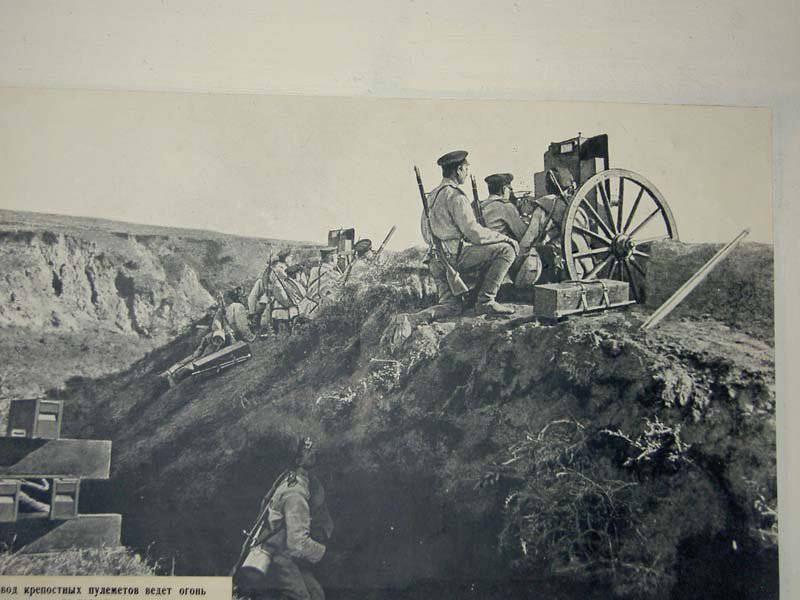
Maxim's machine gun on a serf ("artillery") gun carriage. 1915.
This weapon was no worse than its foreign counterparts; the Russian army was not inferior to the French and German armies in machine gun saturation. The Russian infantry regiment of the 4 battalion (16 company) was armed with a machine gun command from the 6 on May 1910, with Maxim’s 8 machine guns. The Germans and the French had six machine guns per regiment of the 12 company. Russia met a war with good artillery of small and medium caliber, so the 76-mm divisional gun arr. The 1902 of the year (the basis of the field artillery of the Russian Empire) surpassed the 75-mm rapid-fire French and 77-mm German guns in its combat qualities and was highly appreciated by Russian artillerymen. The Russian infantry division had 48 guns, the Germans had 72, the French had 36. But Russia lagged behind the Germans in heavy field artillery (as did the French, British, Austrians). In Russia, the importance of mortars was not appreciated, although there was experience of their use in the Russo-Japanese war.
At the beginning of the 20th century there was an active development of military equipment. In 1902, automobile forces appeared in the Russian armed forces. By World War I, the army had more than 3 thousand cars (for example, the Germans had only 83). The Germans underestimated the role of motor transport, they believed that it was necessary only for advanced, reconnaissance units. In 1911, the Imperial Air Force was established. By the beginning of the war, Russia had the most airplanes - 263, Germany - 232, France - 156, England - 90, and Austria-Hungary - 65. Russia was the world leader in the field of construction and use of seaplanes (aircraft of Dmitry Pavlovich Grigorovich). In 1913 aviation Department of the Russian-Baltic Carriage Works in St. Petersburg under the direction of I.I. Sikorsky was built four-engine aircraft "Ilya Muromets" - the world's first passenger aircraft. After the outbreak of the war, Ilya Muromets created the world's first bomber force out of 4 aircraft.
Since 1914, armored vehicles were actively introduced into the Russian army, and from 1915 the first samples began to be tested. tanks. The first field radio stations created by Popov and Troitsky appeared in the armed forces back in 1900. Used in the Russian-Japanese war, by 1914, “spark companies” were created in all buildings, and telephone and telegraph communications were used.
Military science was developed, the works of a number of military theorists were published: Mikhnevich - “Strategy”, A.G. Yelchaninov - “Leading the modern battlefield”, V.A. Cheremisov - “The Foundations of Modern Military Art”, A.A. Neznamov - "Modern War". In 1912, the “Field Service Regulations”, “Instruction for field artillery actions in combat” were published, in 1914 - “Instruction for infantry actions in combat”, “Instruction on conducting rifle, carbine and revolver”. The offensive was considered the main type of hostilities, but much attention was paid to defense. Offensive infantry used intervals up to 5 steps (more rare battle formations than in other European armies). Climbing, running, and advancement by detachments and individual soldiers from position to position under the cover of their comrades are allowed. They demanded that the soldiers dig in not only in defense, but also in offensive operations. A counter-battle, night-time actions, and a good level of training were shown by Russian artillerymen. The cavalrymen were taught to act not only on horseback, but also on foot. At a high level was the training of officers, non-commissioned officers. The highest level of knowledge gave the Academy of the General Staff.
Of course, there were drawbacks as well, the issue of automatic weapons for infantry was not resolved, although promising designs existed (Fedorov, Tokarev and others worked on them). No mortars were introduced. The preparation of the reserve was very bad, only the Cossacks held training and exercises. Those who dropped out and did not get to the military service did not have any training at all. Bad deal with the officer reserve. These were people who received higher education, they received a rank of ensign with a diploma, but they had no idea about active service. The reserve also included officers who retired in health, in age, for misconduct.
Russia underestimated the possibilities of heavy artillery, succumbed to the influence of French theories and German disinformation (the Germans actively scolded large-caliber guns in the pre-war period). They realized it late, before the war they adopted a new program, according to which they planned to seriously strengthen the artillery: the corps should have had 156 guns, of which heavy - 24. The weak point of Russia was the orientation on foreign manufacturers. The military minister Vladimir Aleksandrovich Sukhomlinov (1909-1915) was not distinguished by high abilities. He was a sensible administrator, but he did not differ in excessive zeal, he tried to minimize efforts — instead of developing domestic industry, he found a simpler way. Chose, ordered, received "gratitude" from the manufacturer, accepted the product.
Russian strategic plan on the eve of the First World War
Schlieffen’s German plan was generally known in Russia. The Germans planted fake Russian intelligence, but the General Staff determined that it was a fake, and “by contradiction” recreated the real designs of the enemy.
The Russian war plan included two scenarios of war. Plan "A" - the Germans deliver the first strike against France, and the "D" plan, if not only Austria-Hungary fights against the Russian Empire, but the Germans will strike the first and main attack against us. In this scenario, the majority of Russian forces were to oppose Germany.
In the first scenario, which was carried out, 52% of all forces (4 armies) were concentrated against Austria-Hungary. With counter blows from Poland and Ukraine, they had to destroy the enemy grouping in Galicia (near Lvov-Peremyshl) and then prepare an offensive in the direction of Vienna and Budapest. Successes against Austria-Hungary were supposed to keep the Kingdom of Poland from a possible uprising. 33% of all forces (2 armies) had to act against the German Empire. They had to deliver converging attacks from Lithuania (from the east) and from Poland (from the south), beat the Germans in East Prussia and create a threat to the central regions of Germany. The actions against Germany should have been delayed by part of the forces of the German army, which acted against France. Another 15% of forces were allocated to two separate armies. The 6 army was supposed to protect the Baltic coast and Petersburg, and the 7 army was to defend Romania and the Black Sea coast.
After mobilization against Germany, the 9 corps (2 armies) had to be deployed, they had 19 infantry divisions, 11 secondary infantry divisions, 9 and a half cavalry divisions. Against Austria-Hungary: 17 Corps, they had 33,5 Infantry Division, 13 Secondary Infantry Divisions, 18 with half cavalry divisions. The 2 Corps with 5 Infantry Divisions, 7 Secondary Infantry Divisions, 3 Cavalry Divisions entered two separate armies. More 9 army corps remained in reserve Headquarters, in Siberia and Turkestan.
It should be noted that Russia was the first country to create such operational units as the front, the North-Western and South-Western fronts. In other countries, all armies closed on a single control body - the headquarters.
Considering the fact that the mobilization periods of the Russian army were late compared with the German and Austro-Hungarian, in Russia they decided to remove the line of deployment of the armies from the German and Austro-Hungarian borders. So that the German and Austro-Hungarian armies could not conduct a concerted attack on Bialystok or Brest-Litovsk and generally along the eastern bank of the Vistula in order to cut off the Russian army from the center of the empire. Against the German forces, Russian troops concentrated on the Shavli line, Kovno, the Neman, Beaver, Narew and Western Bug rivers. This line was removed from Germany by almost five transitions and was a strong defensive line in its natural properties. Against the Austro-Hungarian Empire, the troops were to be concentrated at the turn of Ivangorod, Lublin, Kholm, Dubno, Proskurov. The Austro-Hungarian army was considered not so strong and dangerous.
The connecting factor was the fact that Russia assumed the obligation to simultaneously oppose Germany against France. The French committed themselves to 10 mobilization day to expose 1,3 million people and immediately begin military operations. The Russian side has pledged to put up 800 thousand people by this date (we must take into account the fact that the Russian army was scattered over a vast territory of the country, as well as mobilization reserves) and on the 15 day of mobilization to launch an offensive against Germany. In 1912, it was agreed that if the Germans concentrated in East Prussia, then Russian troops would advance from Narew on Allenshteyn. And in the event that German forces unfold in the region of Thorn, Poznan, the Russians will strike directly at Berlin.
The supreme commander was to become the emperor, and the actual leadership was carried out by the chief of staff, they were the head of the Academy of the General Staff Nikolay Nikolayevich Yanushkevich. The position of quartermaster general, who was responsible for all operational work, was given to Yuri Nikiforovich Danilov. Grand Duke Nikolai Nikolayevich was eventually appointed supreme commander. The rate was created in Baranovichi.
The main weak points of the plan:
- The need to launch an offensive before the completion of mobilization and concentration of forces. On the 15 day of mobilization, Russia could concentrate only about a third of its forces, which led to the fact that the Russian imperial army had to conduct an offensive in a state of partial readiness.
- The need to conduct offensive actions against two strong opponents, it was impossible to concentrate the main forces against one of them.
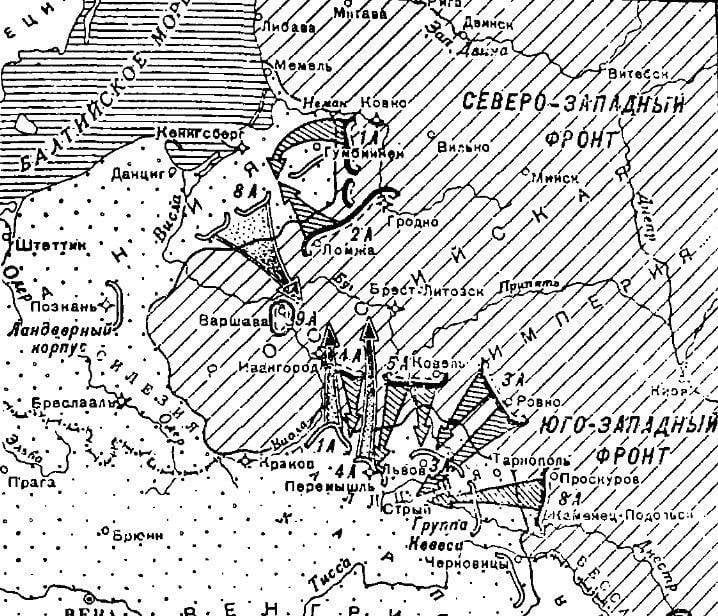
Information